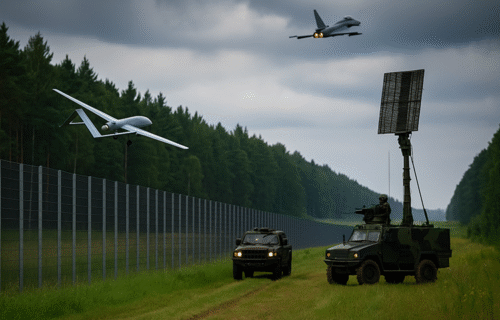The EU is moving to harden its eastern frontier against low-cost unmanned threats after a wave of drones violated Polish airspace this month, prompting Warsaw to trigger Nato consultations under Article 4. The European Commission has signalled support for a common “drone wall” built on interoperable systems and jointly financed procurement, with Brussels also preparing a “drone alliance” with Kyiv to industrialise battlefield-tested Ukrainian technologies. While full details are still being shaped, the initiative dovetails with new EU defence financing tools and Nato’s rapid reinforcement of air defences along the eastern flank.
The sense of urgency sharpened after Poland reported that 19–23 drones entered its airspace on 9–10 September; allied jets intercepted some of the UAVs and several airports temporarily restricted operations. Warsaw invoked Article 4 the following day, saying the incursions posed a direct threat to national and alliance security.
To cover the near term, Nato has launched Operation Eastern Sentry, deploying fighter aircraft, ships and sensors from multiple allies from Finland to Bulgaria to deter and defeat further incursions. French Rafales have already operated over Poland under the mission, according to official and open-source briefings.
At EU level, the Commission has encouraged capitals to co-buy counter-UAS kits proven in Ukraine and to standardise command-and-control so that border states do not field incompatible solutions. The effort aligns with Security Action for Europe (SAFE)—a proposed €150 billion loans facility backed by the EU budget—through which nearly €100 billion could be channelled to the eastern flank for defence investments if governments opt in.
Ukrainian experience is shaping the concept of operations. Because small, low-flying Shahed-type drones can be hard to spot on conventional radar, Kyiv’s industry and military built a nationwide mesh of acoustic sensors, cueing mobile teams with anti-aircraft cannon or heavy machine guns—a far cheaper way to defeat mass drone attacks than expending premium interceptor missiles. Baltic states have begun adapting similar methods, officials say.
Commission officials have also discussed a “drone alliance” with Ukraine, paired with EU financing to scale manufacturing of counter-UAS, detection, and electronic warfare systems, though precise budget lines and instruments are still being refined. The initiative would sit alongside existing EU measures to accelerate joint procurement and strengthen the defence industrial base.
Taken together, the “drone wall” concept, SAFE loans and Eastern Sentry represent a two-track response: Nato provides immediate air-defence cover, while the EU works to stand up a cost-effective, interoperable perimeter built around rapidly scalable tech—much of it proven over Ukraine—so member states can blunt future low-cost aerial threats without burning through expensive missile stocks.
